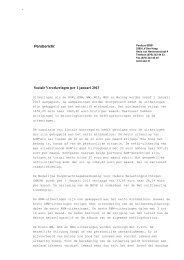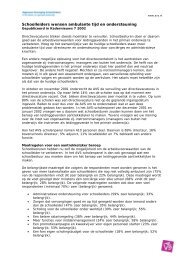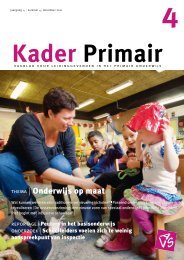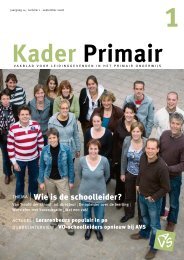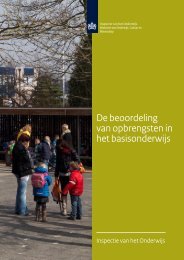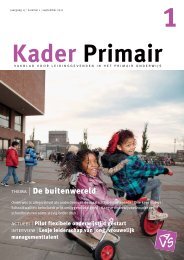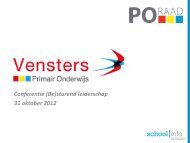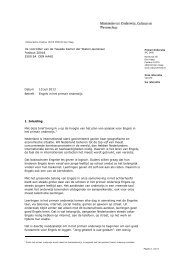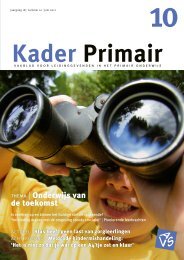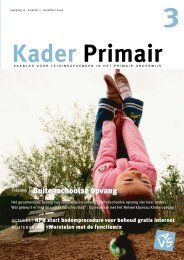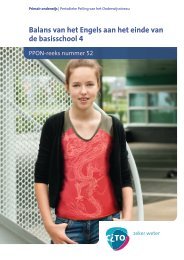Esha Magazine January 2012.pdf
Esha Magazine January 2012.pdf
Esha Magazine January 2012.pdf
Create successful ePaper yourself
Turn your PDF publications into a flip-book with our unique Google optimized e-Paper software.
magazine<br />
Bullying at school:<br />
Prevention and<br />
Intervention<br />
JANUARY 2012
C O L O P H O N<br />
ESHA magazine is the offi cial magazine of the European School<br />
Heads Association, the Association for school leaders in Europe.<br />
ESHA magazine will be published eight times per school year.<br />
You are welcome to use articles from the magazine but we would<br />
appreciate it if you contacted the editor fi rst.<br />
Subscription<br />
The ESHA e-magazine is free of charge. You can register through<br />
the internet at www.eshamagazine.com<br />
The ESHA Executive Board<br />
Ton Duif (President), Chris Harrison (Board member), Clive Byrne<br />
(Board member), Jukka Kuittinen (Board member), Solveig Dahl<br />
(Board member)<br />
About ESHA<br />
ESHA is a Foundation that consists of 32 Associations of Heads<br />
and Educational employers in 25 European countries in primary,<br />
secondary and vocational education.<br />
Contact ESHA<br />
Visiting address: Nieuwegracht 1-3 Utrecht Netherlands<br />
Postal address: Postbox 1003, 3500 BA Utrecht Netherlands<br />
e-mail: e.dejong@avs.nl, www.esha.org<br />
The Editorial team for the magazine<br />
Ton Duif (editor), Chris Harrison, Clive Byrne, Roy Tedscoe, Ellen de Jong.<br />
This edition is sponsored by the AVS, the Netherlands.<br />
Layout and design<br />
Thoben Offset Nijmegen<br />
www.thoben-offset-nijmegen.nl<br />
2 ESHA MAGAZINE JANUARY 2012
In this issue<br />
<strong>January</strong> 2012<br />
4 Column Ton Duif<br />
6 Political infl uence on education<br />
10 An account of a six country collaborative<br />
Comenius project<br />
16 Euthanasia: an issue that refuses to die<br />
20 Prevention & Intervention<br />
30 Nyt ledelsesværktøj<br />
37 Schweiß und Tränen: Der PISA Erfolg Shanghais<br />
42 Primary School Heads Association in Bosnia<br />
and Herzegovina<br />
48 Career development of teaching professionals<br />
with managerial responsibilities<br />
52 The widening quality gap between Finnish vocational<br />
versus general education<br />
ESHA MAGAZINE JANUARY 2012 3
COLUMN TON DUIF<br />
It’s<br />
Comenius<br />
time<br />
Dear ESHA friends and members,<br />
The European Commission has launched the new call for programs<br />
in the Life Long Learning (LLL) programs Erasmus and Comenius.<br />
To enter such a program, you have to submit a bid refl ecting one<br />
of the topics in the LLLprogram. Because ESHA represents school<br />
heads in primary, secondary and vocational education, we are<br />
involved in the Comenius program.<br />
ESHA represents 89,000 school heads in 25 countries in Europe.<br />
This makes us a wanted partner in a lot of Comenius bids. Because<br />
these bids must have been submitted before the beginning of<br />
February, a lot of associations want to work with us, using our dissemination<br />
tools like the interactive ESHA website and this <strong>Magazine</strong>,<br />
subscribed by more than 40,000 school heads in Europe.<br />
4 ESHA MAGAZINE JANUARY 2012
COLUMN TON DUIF<br />
ESHA is a member of EUCIS, the European Civil Society Platform<br />
on Lifelong Learning. EUCIS has criticised the very bureaucratic<br />
system that the EU uses. You have to fill in a pre-form that would<br />
take a lot of work to complete, there is little transparency on the<br />
actual awarding process and when you’ve fi nished the program,<br />
you will fi nd yourself in a breath-taking accountability program.<br />
This should be modifi ed because otherwise only big, professional<br />
organisations can work with these programs, excluding smaller,<br />
less professional organisations, which could have good programs.<br />
I’ve spoken with the EC commissioner for Education Mrs Androulla<br />
Vassiliou. We will see what the EC is going to do with it.<br />
This is the fi rst ESHA <strong>Magazine</strong> in 2012. More will follow. I would like<br />
to wish all of you the best for 2012 and hope to meet a lot of you in<br />
October in Edinburgh on ESHA’s conference.<br />
Ton Duif<br />
ESHA president<br />
ESHA MAGAZINE JANUARY 2012 5
GUEST COLUMN<br />
Political infl uence<br />
on education<br />
BY IAN BAUCKHAM - ASCL<br />
As school leaders across Europe, we are well used to working with<br />
politicians, or, at least, to politicians either telling us what they<br />
believe education should be like or using the strengths and weaknesses<br />
of our schools to score political points. Here in England we<br />
are working in a highly charged political context at the moment, with<br />
free market, conservative educational politics in the ascendency.<br />
The secretary of state (or senior minister) for education, Michael<br />
Gove, is leading a radical transformation of English schools (I say<br />
‘English’ advisedly, as Scotland, Wales and Northern Ireland have<br />
complete autonomy in education). The cornerstone of the reforms<br />
is the creation of a network of quasi autonomous schools, known<br />
as ‘academies’. These schools have a larger measure of independence<br />
from local education authorities, for example receiving their<br />
annual funding directly from central government. Moreover, they<br />
are not required to adhere to the national curriculum, which other,<br />
non-academy, schools must follow, and they are free to employ<br />
6 ESHA MAGAZINE JANUARY 2012
GUEST COLUMN IAN BAUCKHAM<br />
teachers under different terms and conditions to those in force<br />
nationally. Additionally, community groups, including parents, are<br />
being encouraged to create brand new schools in areas where it is<br />
felt that there is complacency in education or where there are insuffi<br />
cient ‘good’ schools. These parent or community-led initiatives,<br />
for which there is generous funding set aside at a time of austerity<br />
elsewhere in the system, are known as ‘free schools’.<br />
The vision is to make parental<br />
choice of schools more<br />
meaningful, to encourage the<br />
I would advocate infl uential private schools in<br />
England to inspire autonomous<br />
ourselves actively<br />
state schools, and, assisted<br />
engaging with by the relentless publication<br />
of performance data about<br />
politics and the individual schools, to make<br />
school provision much more<br />
political debate<br />
diverse and market-oriented,<br />
and much less like an allencompassing<br />
and uniform<br />
around education<br />
public service.<br />
Of course, one can agree or<br />
disagree with this vision, and one’s stance is likely to be determined<br />
by where one stands politically. Those on the left are far more likely<br />
to be opposed to the fragmentation of an equitable public service<br />
and see the marketization of education as likely to benefi t disproportionately<br />
the affluent or privileged. And it would be quite wrong<br />
to see the current government’s reforms as the implementation of<br />
an ‘Anglo-Saxon’ market model – these are highly controversial<br />
reforms even in England, and the conservative party, their main<br />
proponents, have rarely secured more than 40% of the popular<br />
vote. Similar reforms are most unlikely to take place elsewhere in<br />
ESHA MAGAZINE JANUARY 2012 7
GUEST COLUMN IAN BAUCKHAM<br />
the UK, and in other parts of the English-speaking world opinion is<br />
similarly divided.<br />
Despite many misgivings about some of the current politicallyinspired<br />
reforms, I would defend the notion that education should<br />
be politically influenced. Politics at source is the art, or science, of<br />
managing the affairs of the polis, the city-state. What more central<br />
topic can there be to the affairs of our social units than how we<br />
organise the education of our young people This enterprise cannot<br />
be seen as the private property of any individual or cadre of<br />
professionals – it should, in my view, in a democratic society, in<br />
in the realm of politics. I would advocate not complaining about<br />
‘politicians interfering’ in professional matters, but rather ourselves<br />
actively engaging with politics and the political debate around education.<br />
This will help to regenerate our democracies, reinvigorate our<br />
societies and re-engage a wider range of people with all-important<br />
questions of how to prepare the next generation of young people<br />
for live in our communities. <br />
8 ESHA MAGAZINE JANUARY 2012
Agenda<br />
2012<br />
March 2–3<br />
ESHA Spring meeting in Ljubljana, Slovenia<br />
March 15–16<br />
AVS Master classes & Conference in Utrecht, The Netherlands<br />
March 7–12<br />
NAESP Conference, Tampa, USA<br />
March 22–24<br />
NAESP Conference, Seattle, USA<br />
March 23–24<br />
ASCL Annual Conference in Birmingham<br />
March 28–29<br />
Nordic School Leader Conference in Gothenburg, Sweden<br />
May 4–6<br />
NAHT conference in Harrogate, UK<br />
October 29–31<br />
13th ESHA Biennial Conference in Edinburgh, Scotland<br />
ESHA MAGAZINE JANUARY 2012 9
PROJECT<br />
An account<br />
of a six country<br />
collaborative<br />
Comenius project<br />
BY IAN BAUCKHAM<br />
Background to the lead school<br />
The lead school in this project is the school where the author of this<br />
article is the headteacher, and has been since 2004. It is a co-educational<br />
school of some 1500 students aged 11 to 18 situated in Tunbridge Wells<br />
in Kent, south east England. It is a Church of England state school, which<br />
means that the funding is provided by the state (initially the local authority,<br />
and since 2011 directly from central government in Westminster). In<br />
2008 the decision was made to try to increase the range of international<br />
projects undertaken, and the responsibility for international development<br />
was part of the role of a newly appointed assistant headteacher. This<br />
headteacher joined the leadership team of one headteacher, two deputy<br />
headteachers, and three assistant headteachers, along with a business<br />
manager and a personnel (human resources) manager.<br />
10 ESHA MAGAZINE JANUARY 2012
AN ACCOUNT OF A SIX COUNTRY COLLABORATIVE COMENIUS PROJECT<br />
The author of this article, as headteacher, had a long standing commitment<br />
to international links, and as representative in ESHA for the<br />
Association of School and College Leaders had made a number of<br />
informal contacts abroad. The suggestion was made of applying for<br />
Comenius funding for a multilateral collaborative project involving a<br />
range of European countries and enabling young people from across<br />
Europe to come together in each others’ countries in turn, over a<br />
2 to 3 year period, to undertake project work on specifi c themes and<br />
to assist in the process of building understanding between nations.<br />
A bid was duly compiled and submitted to Brussels in 2009. It was<br />
some time before we heard back, but were delighted to be offered<br />
funding.<br />
Six nations working together – Sweden, England, Netherlands, Germany, Italy and<br />
Finland. Some of the Comenius students who produced the Comenius magazine to<br />
summarise their week in England.<br />
ESHA MAGAZINE JANUARY 2012 11
AN ACCOUNT OF A SIX COUNTRY COLLABORATIVE COMENIUS PROJECT<br />
Scope of involvement in the project<br />
The countries involved were England (the lead country and initiator of<br />
the project); the Netherlands; Germany; Italy; Finland; and Sweden.<br />
The partner schools were identifi ed by a mixture of existing and<br />
new contacts. Some of these were facilitated by the headteacher<br />
of the English school using contacts made through his international<br />
activities.<br />
Planning the project<br />
Having provisionally secured approval for our plans, the next step<br />
was to organise a planning conference of teachers from each of<br />
the partner schools. This took place in Tunbridge Wells in the<br />
autumn of 2009. The underlying theme of all the projects is about<br />
developing, growing and nurturing young people as future leaders.<br />
Consequently the programme of collaboration has aimed to provide<br />
a range of learning opportunities in which students are encouraged<br />
to be active citizens rooted in a secure knowledge of their particular<br />
subject interests. Each leg of the project involved 4 students from<br />
each country, so 24 in total, and two teachers from each country.<br />
The principle was agreed of allowing different students access to<br />
each leg, thus ensuring that some 24 from each country have been<br />
involved directly over the project’s lifespan, a total of 144 altogether,<br />
plus their teachers. Strategies were identified for feeding back the<br />
experience and insights to other students and the rest of the school<br />
at the end of each leg.<br />
Themes of each stage of the project<br />
The themes of each Comenius visit have been:<br />
• Sweden – September 2010 – developing sports leadership. Each<br />
participating school spent time coaching students from the other<br />
schools in a particular sport. So, for example, the English school<br />
12 ESHA MAGAZINE JANUARY 2012
AN ACCOUNT OF A SIX COUNTRY COLLABORATIVE COMENIUS PROJECT<br />
played some of a unique Kentish game, stool ball, with the other<br />
schools.<br />
• Germany – November 2010 – understanding the nature of society<br />
and developing communication skills. All schools gave presentations<br />
on how each country celebrates Christmas to residents of<br />
an old people’s home. The project was focused on how old age is<br />
something to be celebrated. It helped equip students with a better<br />
understanding of the issues facing the elderly and how they<br />
can and should be nurtured within society.<br />
• Italy – March 2011 – understanding the impact of individuals in<br />
making a difference – the week considered the impact of war<br />
within the immediate regions of each school and how it has<br />
shaped the social landscape since. Each school learnt about<br />
different individuals from each country that could be viewed as<br />
‘heroes’ – and why.<br />
• Finland – September 2011 – environmental leadership. Work was<br />
based upon the myriad of socio-economic-political issues related<br />
to water management in the region of Imatra (the location of the<br />
Finnish school). Students learnt how water is managed and ways<br />
forward to creating a sustainable future.<br />
• UK – November 2011 – ethics conference. Students prepared<br />
detailed presentations on fi ve key ethical issues facing our<br />
countries at the beginning of the 21st century. These included<br />
for example just war, euthanasia, drug traffi cking and ‘you are<br />
what you eat’. After a range of research and discussion based<br />
activities, students chose one central issue which they felt most<br />
relevant to their concerns across Europe. They selected euthanasia.<br />
Having prepared their presentation and debate representing<br />
both sides of this complex issue, they took part in a visit to the<br />
historic Houses of Parliament in Westminster, and were privileged<br />
to be able to conduct the debate in the presence of the member<br />
of Parliament for Tunbridge Wells, Greg Clark MP, using one of the<br />
ESHA MAGAZINE JANUARY 2012 13
AN ACCOUNT OF A SIX COUNTRY COLLABORATIVE COMENIUS PROJECT<br />
House of Commons committee rooms. This was possible through<br />
the mediation of one of Greg Clark’s personal staff, who is a parent<br />
at the English school. Following the debate, during which Mr<br />
Clark assisted the students in presenting their views in the style<br />
of a Westminster debate, the group of 24 young people and their<br />
10 teachers was given a tour of both chambers, including access<br />
to a number of rooms normally reserved for senior fi gures in the<br />
British establishment.<br />
Through their work in Parliament<br />
students were able to better<br />
understand how ethical issues<br />
underpin our societies. They were<br />
also able to develop their debating<br />
skills considerably – a vital skill for<br />
future leaders in society. The last<br />
day was spent putting together a<br />
student magazine reporting some<br />
of the key lessons and experiences,<br />
an extract of which follows<br />
this article. There was also time<br />
for recreation and team building,<br />
essential for any successful joint<br />
international project, with a music<br />
workshop day and a visit to a<br />
local curling rink.<br />
The final leg of the Comenius project is scheduled to take place in<br />
April 2012 in the Netherlands and will take as its theme linguistic<br />
diversity, culminating with a young persons’ Model United Nations<br />
General Assembly<br />
Through their<br />
work in Parliament<br />
students were<br />
able to better<br />
understand how<br />
ethical issues<br />
underpin our<br />
societies<br />
14 ESHA MAGAZINE JANUARY 2012
AN ACCOUNT OF A SIX COUNTRY COLLABORATIVE COMENIUS PROJECT<br />
Outcomes<br />
Of course, one of the key by-products of all these meetings is that<br />
students have a much better understanding of different European<br />
perspectives not only on the visit theme but also of the issues facing<br />
young people across Europe. The social connections made at<br />
these conferences help develop a deeper global perspective – and<br />
get them thinking beyond the confi nes of their town and country.<br />
Moreover, understanding will have increased between young people<br />
of different nations, barriers, prejudices and preconceptions broken<br />
down, and a small contribution made to building future peace and<br />
collaboration in our common European home.<br />
The participating schools<br />
• Bennett Memorial Diocesan School, Tunbridge Wells (England)<br />
• Imatran Yhteisluko, Imatra (Finland)<br />
• Eduard Stieler Schule, Fulda (Germany)<br />
• Liceo Russell, Cles (Italy)<br />
• Visser t’Hooft Lyceum, Leiden (Netherlands)<br />
• Västerhöjdgymnasiet, Skövde (Sweden)<br />
Ian Bauckham is headteacher at Bennett Memorial Diocesan School.<br />
Until 2011 chair of international committee of Association of School<br />
and College Leaders (ASCL) and ASCL ESHA representative.<br />
ESHA MAGAZINE JANUARY 2012 15
AN ACCOUNT OF A SIX COUNTRY COLLABORATIVE COMENIUS PROJECT<br />
SOMMAIRE EN FRANÇAIS<br />
Compte-rendu d’un<br />
partenariat Comenius<br />
entre six pays<br />
L’auteur de cet article, Ian Bauckham, dirige la Bennett Memorial<br />
Diocesan School à Tunbridge Wells, à l’initiative de laquelle un<br />
partenariat Comenius a été mis en place dès 2009. Ce dernier a<br />
permis à 144 élèves et leurs professeurs, en provenance des Pays-<br />
Bas, de l’Allemagne, de l’Italie, de la Finlande, de la Suède et du<br />
Royaume-Uni de travailler ensemble sur divers thèmes, dans le but<br />
de renforcer la compréhension entre les nations et de développer<br />
chez les jeunes les compétences nécessaires aux futurs leaders.<br />
Voici un aperçu des thèmes étudiés tout au long du partenariat:<br />
• Suède, septembre 2010: développer le leadership dans les sports;<br />
• Allemagne, Novembre 2010: comprendre la nature de la société et<br />
développer les capacités de communication;<br />
• Italie, mars 2011: comprendre la capacité que chaque individu<br />
a de changer les choses ;<br />
• Finlande, septembre 2011: la responsabilité environnementale<br />
et les solutions pour un avenir durable;<br />
• Royaume-Uni, novembre 2011: conférence autour de cinq défi s<br />
éthiques que nos sociétés ont à relever en ce début de 21e<br />
siècle; A l’issue des discussions, les élèves ont choisi le thème<br />
de l’euthanasie afi n d’en débattre au sein de la Chambre des<br />
16 ESHA MAGAZINE JANUARY 2012
AN ACCOUNT OF A SIX COUNTRY COLLABORATIVE COMENIUS PROJECT<br />
Communes, à Westminster, en la présence de Greg Clark,<br />
le représentant de Tunbridge Wells au Parlement (voir l’article<br />
à la suite de ce compte-rendu). Comprendre la place de l’éthique<br />
dans nos sociétés, défendre et débattre d’un point de vue, rédiger<br />
un compte-rendu et travailler en équipe sont autant de compétences<br />
attendues des futurs leaders;<br />
• Pays-Bas, avril 2012: le thème de la diversité linguistique sera<br />
débattu au sein d’une Assemblée Générale des Nations Unies<br />
des Jeunes.<br />
Appréhender les défi s qu’ils ont en commun a permis aux élèves<br />
de penser au-delà des frontières nationales. Comprendre les<br />
différences pour affaiblir les préjugés: ce partenariat Coménius<br />
contribue à la paix et à la coopération futures au sein de notre<br />
maison européenne.<br />
L’euthanasie: un débat qui refuse de mourir<br />
C’est autour de la question de la légalisation de l’euthanasie active<br />
en cas de souffrance physique insupportable que s’est articulé le<br />
débat à Westminster. Les intervenants contre la légalisation arguèrent<br />
de la diffi culté de déterminer à 100% la volonté de la personne<br />
demandant l’euthanasie, de notre héritage chrétien qui nous enseigne<br />
le caractère sacré de la vie et de la frontière trop ténue entre<br />
euthanasie et crime. En réponse, les pro-légalisation rappelèrent le<br />
droit qu’a tout homme de contrôler sa vie, le droit de mourir dignement<br />
et la diversité des croyances religieuses en Europe.<br />
Les élèves du partenariat Coménius ont compris les enjeux de la<br />
question de l’euthanasie, ont débattu selon les règles propres au<br />
Parlement, ont appris l’art de parler professionnellement et ont<br />
découvert des coutumes et cultures différentes des leurs. Pour<br />
toutes ces raisons, cette journée fut un véritable succès !<br />
ESHA MAGAZINE JANUARY 2012 17
SURVEY<br />
Euthanasia:<br />
an issue that<br />
refuses to die<br />
ARTICLE WRITTEN COLLABORATIVELY BY STUDENT PARTICIPANTS<br />
IN THE COMENIUS PROJECT<br />
Yesterday, a group of students from various different<br />
European countries visited the Houses of Parliament<br />
to debate the very controversial topic of euthanasia.<br />
Greg Clark, Conservative MP for Tunbridge Wells and<br />
Minister of State for Decentralisation and Planning Policy,<br />
chaired this debate and made it as much of a realistic<br />
experience as possible. It was voted that the statement<br />
to be discussed was ‘This House would legalise active<br />
Euthanasia for unbearable physical suffering’.<br />
18 ESHA MAGAZINE JANUARY 2012
EUTHANASIA: AN ISSUE THAT REFUSES TO DIE<br />
In order to make this as realistic as possible, there were opening<br />
speakers from the two sides of the argument. Helmiina Suuronen,<br />
from Finland, who was in favour of the motion, opened the debate.<br />
She briefl y discussed the main issues which included that all<br />
human beings should have control over their own lives. Tim Chase,<br />
from England, was opposing the argument; he introduced his ideas<br />
which included that you can never be one hundred per cent sure<br />
that the person requesting euthanasia is certain that they want it.<br />
He also said that legalising euthanasia could lead to the increase in<br />
crime and that as a country we should aim to kill the pain and not<br />
the patient.<br />
Throughout the hour, students learnt about the practicalities of having<br />
a debate in the House of Commons. For example how to address<br />
one another as an ‘honourable member’ and how to intervene the<br />
opposing speaker – ‘will you give way’ Everyone had the chance<br />
to express their opinions during the debate and the students were<br />
becoming passionate and involved. Janne Laitila, from Finland, was<br />
against the motion. His arguments<br />
were ‘Life is a gift from God’ and<br />
‘who are we to decide when one’s<br />
life comes to an end’ Paulina van<br />
der Doe, from the Netherlands,<br />
challenged his statements saying<br />
that ‘Many people aren’t Christian<br />
so they don’t believe in sanctity of<br />
life’.<br />
Taylor Mae Bouwman, from the<br />
Netherlands, was for the argument<br />
and quoted a story about<br />
Guusje, a Dutch girl, who recently<br />
ESHA MAGAZINE JANUARY 2012 19
EUTHANASIA: AN ISSUE THAT REFUSES TO DIE<br />
The presentation and debate took place in the historic Houses<br />
of Parliament in Westminster<br />
20 ESHA MAGAZINE JANUARY 2012
EUTHANASIA: AN ISSUE THAT REFUSES TO DIE<br />
died from euthanasia and quoted words from her father saying ‘the<br />
cancer was destructive. It ruined her body. We helped her. She died<br />
in dignity surrounded by people who loved her. It has been good.<br />
For our hero Guusje.’<br />
Johan Lindberg, from Sweden, concluded with a speech against<br />
the motion saying ‘Where do we draw the line between legal euthanasia,<br />
and murder’ as well as ‘Euthanasia should not be legalised<br />
because it could lead to dangerous consequences and increasing<br />
the moral decay of society.’<br />
Jacomijn Guijt, from the Nether lands, was in favour of the motion<br />
and concluded by saying ‘We are not in favour of death, we are in<br />
favour of life…we should be able to say stop when life cannot offer<br />
anything more.’<br />
To decide whether the motion should be passed or not, Greg Clark<br />
showed the students how to vote in parliament. First of all, he asked<br />
who was in favour and who was against the motion in order to try<br />
to decide which side had the most votes. It was not possible to tell<br />
this so he called for division.<br />
He chose two people from each side to count the members in favour<br />
and against the motion so that it couldn’t be biased. The result of<br />
the vote was ‘the aye to the left 15, the no’s to the right 12’ so the<br />
‘parliament’ had approved the motion.<br />
The day was successful and the students learnt a lot, not only about<br />
euthanasia, but also how to debate in the House of Commons. All of<br />
the students were from different nations and this experience taught<br />
them to speak professionally and confi dently as well as learning<br />
about different customs and cultures. <br />
ESHA MAGAZINE JANUARY 2012 21
CONFERENCE<br />
Prevention<br />
& Intervention<br />
Conference at Trinity tackles bullying<br />
BY DEREK WEST<br />
The presence of Minister for Children, Frances<br />
Fitzgerald, at the one-day conference, Bullying at School,<br />
at Trinity College, Dublin, on November 10, underlined<br />
the importance of the topic; the range of contributions<br />
from the UK, Australia, Norway, Finland, as well as from<br />
the growing cohort of researchers and specialists in this<br />
country, served to raise awareness of the teachers, the<br />
Principals and the parents [a few] who attended.<br />
22 ESHA MAGAZINE JANUARY 2012
Bullying is a big issue in all schools and while cyber bullying may<br />
be the current aspect under the microscope, it’s really only a subset<br />
of the behaviour [that form of persistent, proactive aggression]<br />
that has such an impact on the learning and living of a substantial<br />
number of children.<br />
If we are to ‘get real’ about tackling bullying, we have to deal with<br />
it on a national level and we have to put signifi cant resources into<br />
developing a programme that will foster good practice, join up<br />
the dots between the various agencies with responsibility for the<br />
welfare of children and offer ways and means to counteract the<br />
negative behaviour when it occurs.<br />
The KiVa model<br />
The outstanding model, in this regard, is the KiVa anti-bullying<br />
programme which has been developed at the University of Turku<br />
ESHA MAGAZINE JANUARY 2012 23
CONFERENCE AT TRINITY TACKLES BULLYING<br />
in Finland and implemented across the comprehensive school system<br />
[82% of the 3,00 schools, covering grades 1-9, ages 7-17] in<br />
that country. The fi rst object lesson to take on board is that the<br />
scheme had the solid backing of the Finnish Government, which<br />
responded with the resources to address a problem that had been<br />
a big concern since the 1990s. Christina Salmivalli [Professor of<br />
Psychology at Turku University, currently leading the development<br />
and evaluation of KiVa] described<br />
the programme and how it arose<br />
from the commitment to making<br />
a priority of the prevention of bullying,<br />
on the premise that it’s the<br />
right of the child to exist in a ‘safe<br />
school environment’. While each<br />
school is encouraged to develop<br />
its own policy, KiVa is available as<br />
a country-wide support system,<br />
based on philosophical principles<br />
but offering systematic, practical<br />
assistance.<br />
Christina Salmivalli<br />
The programme divides into<br />
universal and indicated actions.<br />
Universal actions consist of a range of highly-developed and varied<br />
educational materials – teachers’ guides, short fi lms, experiencebased<br />
lessons. There is a bank of presentation graphics to animate<br />
lessons, meetings of school personnel and with parents. All the<br />
stakeholders have access to a web-site and a virtual learning<br />
environment. There are computer games, posters and even highvisibility<br />
vests for those supervising the playgrounds. The provision<br />
is thorough and exhaustive.<br />
24 ESHA MAGAZINE JANUARY 2012
CONFERENCE AT TRINITY TACKLES BULLYING<br />
Indicated actions come into play when a specifi c instance of bullying<br />
arises in the school. Each particular case is handled in a series<br />
of individual and group discussions between the school’s KiVa team<br />
and the students involved.<br />
The KiVa approach focuses on four groups: the victims, the bullies,<br />
the bystanders and the school authorities. Each has a crucial role.<br />
The victim needs to feel heard and helped. The abiding negative<br />
memory for many victims, looking back, is that ‘no-one cared’.<br />
Even in the presence of a highly-developed scheme, people can<br />
be overlooked. KiVa is currently rolling out a ‘virtual mailbox’ which<br />
allows individuals to disclose instances of bullying.<br />
The bullies need to be confronted, but throughout the day there<br />
was a repeated affirmation of the limited value of punitive measure<br />
to cope with bullying; The behaviour of the bystanders does matter<br />
[the programme aims to enhance awareness of, and empathy<br />
for, the victims of bullying; to propose safe strategies to allow the<br />
bystanders to support them]<br />
Prosocial peers – Underlining this programme – and similar initiatives<br />
such as those in the UK and Australia – is the concept of peer<br />
support, of involving young people in being attuned to positive,<br />
‘prosocial’ actions.<br />
Teachers’ training includes the use of a diary/notebook, which is<br />
used to document the specifi c instances and the responses. School<br />
authorities are expected to be pro-active [even when the bullying –<br />
as in cyberspace – mostly happens beyond the school walls].<br />
Professor Salmivalli alluded to the evaluation that shows a signifi -<br />
cant decrease in bullying, since the inception and roll-out of KiVa,<br />
but she was also anxious to point out the challenge involved in<br />
maintaining such a programme, in inventing the actions that keep<br />
up the good work.<br />
ESHA MAGAZINE JANUARY 2012 25
CONFERENCE AT TRINITY TACKLES BULLYING<br />
Addressing Systems Errors<br />
This was a theme that was complemented by Gaute Bjornsen of<br />
the Connect Oslo Schools Programme. His preoccupation was<br />
implementation. Yes, we have to have the willingness, the wisdom,<br />
the integrity; we have to have the philosophical basis; we have to<br />
have the resources. But Bjornsen maintains that well-funded programmes<br />
are not enough, there has to be effort and commitment,<br />
follow-up and implementation. He’s all for ambitions and expectations<br />
but there have to be daily routines to incorporate the ideas.<br />
‘It is far better that all teachers and classes master the basic social<br />
skills every day, than to have some teachers and classes perform<br />
advanced things now and then’.<br />
His approach was refreshingly pragmatic and was as applicable<br />
to most areas of educational enterprise as to bullying. He saw the<br />
multi-tasking of schools as problematic – ‘many schools juggle<br />
Professor Mona O’Moore with Frances Fitzgerald, Minister for Children<br />
26 ESHA MAGAZINE JANUARY 2012
CONFERENCE AT TRINITY TACKLES BULLYING<br />
far too many balls’ - and asserted that it’s vital to ‘prioritise the<br />
essence’.<br />
The core of his presentation was about learning from common systems<br />
errors. He was caustic about complacency, ‘foggy values and<br />
foggy thinking’, the reluctance to ‘do’ systems analysis and to act<br />
upon it. Taking systems errors for granted turns us into underachievers.<br />
In his clinical, considered and precise English, he demanded<br />
that we ‘be bolder, more honest in addressing what everybody<br />
knows.’ We need to be open to changing the ways we work.<br />
There common error that received most opprobrium was behaviour<br />
management by means of rules and sanctions, the practice<br />
of either ignoring or demonising students who bully. Given that<br />
statistics offered at the conference pointed to a signifi cant group<br />
of victim/bullies [those who bullied and were bullied] and who<br />
shared with both bullies and victims long-term symptoms of stress,<br />
anger, depression, diffi cult relationships, it was unsurprising to fi nd<br />
restorative problem-solving methods being regarded as much more<br />
appropriate and effective. Bjornsen expanded on this – seeing both<br />
victims and bullies are being in danger. ‘Most bullies are trapped<br />
in a game and in a role of which they have lost control.’ Change<br />
becomes possible if all parties understand the mechanisms in<br />
bullying. He repeats the need for parental involvement. He sees<br />
the parents as vital participants – the school must communicate<br />
its values, sharing its thinking, co-operate with parents – a good<br />
relationship between school an d parents ‘often is the key to both<br />
solving an preventing bullying’. The classroom is a vital location for<br />
the development of collective social skills.<br />
If KiVa offers a package of well-developed strategies, Bjornsen is<br />
advocating active defi nition of values –‘you have to do the defi n-<br />
ing’ – and principles. A clear perception of children (and adults) is<br />
vital; there has to be consensus around core actions, strategies<br />
and principles. His emphasis was on relationships – he showed a<br />
ESHA MAGAZINE JANUARY 2012 27
CONFERENCE AT TRINITY TACKLES BULLYING<br />
‘Triangle of Trust’, with the student at the centre, school at the apex<br />
and the parents at the base.<br />
Cyber bullying<br />
Much of the day focused on cyber bullying as the most recent<br />
manifestation of the behaviour. Texting, mobile phones, e-mail,<br />
U-Tube and all the other means of electronic communication have<br />
been recruited by bullies since the beginning of the 1990s. The<br />
early instances were by texting and as young people have gained<br />
increasing access to the means of communication, so has the number<br />
of episodes involving technology as a means of bullying.<br />
Helen Cowie, a Professor at the University of Surrey, identified the<br />
types of cyber bullying [Harassment, Denigration, Outing and ‘trickery’<br />
-the circulation of the personal and the private - and exclusion]<br />
and Peter Smith [Professor of Psychology at Goldsmith College],<br />
characterised cyber bullying:<br />
Cyber bullying<br />
28 ESHA MAGAZINE JANUARY 2012
CONFERENCE AT TRINITY TACKLES BULLYING<br />
• It depends on the bully having some technical expertise;<br />
• It is indirect, rather than face to face; the perpetrator does not see<br />
the victim’s reaction;<br />
• The motives of the bully are different;<br />
• The role of the bystander is complex;<br />
• The breadth of the potential audience is greatly increased<br />
• For the victim, there is no place to hide, no respite<br />
Bullying<br />
Cyber Bullying<br />
• Direct<br />
• Anonymous<br />
• Occurs on school property<br />
• Occurs off school property<br />
• Poor relationships with<br />
teachers<br />
• Good relationships with<br />
teachers<br />
• Fear retribution<br />
Physical: hitting, punching<br />
and shoving<br />
Verbal: teasing, name calling<br />
and gossip<br />
Non verbal: use of gestures<br />
and exclusion<br />
• Fear loss of technology<br />
privileges<br />
• Further under the radar<br />
than bullying<br />
• Emotional reactions cannot<br />
be determined<br />
ESHA MAGAZINE JANUARY 2012 29
CONFERENCE AT TRINITY TACKLES BULLYING<br />
Bullying can lead to exclusion.<br />
The levels are still relatively low and the coping strategies are, for<br />
the most part, similar to those applied to ‘traditional’ bullying. But<br />
two disturbing factors emerge:<br />
One is that schools are sometimes ambivalent about their responsibilities<br />
with regards to cyber bullying. As it is more often than not<br />
it instigated outside hours and beyond the walls, some schools are<br />
washing their hands of the issue. Professor Mona O’Moore, who<br />
has been the leading light in promoting the examination, research<br />
and development of bullying issues in Ireland, is unequivocal about<br />
this. The effects reverberate in the classroom – therefore schools<br />
have to acknowledge cyber bullying and address it.<br />
The other factor, reverberating in a number of studies, is the low<br />
incidence of bully victims confi ding in teachers. <br />
30 ESHA MAGAZINE JANUARY 2012
CONFERENCE AT TRINITY TACKLES BULLYING<br />
References<br />
• KiVa: tiina.salmivalli@utu.fi<br />
• Gaute Bjornsen: gaute.bjornsen@gbreflektor.no<br />
• The Centre for Evidence Based Early Intervention [Bangor<br />
University] is holding a KiVa programme on May 22 [Bangor]<br />
and 23 [Cardiff]. Details, bookings from j.hutchings@bangor.<br />
ac.uk<br />
• Anti-Bullying Campaign – Tools for Teachers. A free websitebased<br />
anti-bullying programme for Irish secondary schools:<br />
www.antibullyingcampaign.ie<br />
• ABC: Anti-Bullying Centre TCD: Has published Silent<br />
Witnesses, a DVD and workbook that is designed to assist<br />
schools and parents prevent bullying. See website:<br />
www.abc.tcd.ie<br />
• Understanding School Bullying by Mona O’Moore, published<br />
by Veritas. www.veritasbooksonline.comona<br />
• Dealing with Bullying in Schools by Mona O’Moore and<br />
Stephen James Minton, published by Paul Chapman:<br />
www.paulchapmanpublishing.co.uk<br />
ESHA MAGAZINE JANUARY 2012 31
CONFERENCE AT TRINITY TACKLES BULLYING<br />
SOMMAIRE EN FRANÇAIS<br />
Le harcèlement<br />
scolaire<br />
Prévention et<br />
intervention<br />
Le modèle KiVa<br />
Il s’agit d’un programme de lutte contre le harcèlement scolaire,<br />
développé et mis en place en Finlande, et présenté par Christina<br />
Salmivalli, en charge de son développement et de son évaluation.<br />
Bénéfi ciant d’un solide soutien du gouvernement, le programme est<br />
né de l’engagement de faire de la prévention contre le harcèlement<br />
scolaire une priorité.<br />
Le programme comprend des actions générales – initiatives qui<br />
s’adressent à tous les élèves de la même école au moyen d’un<br />
matériel éducatif très diversifié mis à la disposition de tous – et des<br />
actions ciblées – qui interviennent lorsqu’un cas de harcèlement<br />
est repéré.<br />
L’approche KiVa se concentre sur le rôle de quatre groupes: la victime<br />
doit se sentir écoutée et aidée; l’agresseur doit être confronté<br />
à ses actes; les camarades ont un rôle positif de soutien à jouer; et<br />
l’équipe éducative doit être proactive.<br />
Les résultats sont signifi catifs mais reste la question du maintien et<br />
du développement du programme sur le long-terme.<br />
32 ESHA MAGAZINE JANUARY 2012
CONFERENCE AT TRINITY TACKLES BULLYING<br />
Corriger les erreurs<br />
La maîtrise des règles fondamentales de vie en société au quotidien<br />
par les professeurs et les élèves serait plus effi cace que la création<br />
de nouveaux programmes certes avancés, mais limités dans<br />
le temps et l’espace. L’approche présentée par Gaute Bjornsen,<br />
membre du programme Connect Olso Scools, est pragmatique:<br />
La nécessité pour l’école de s’attaquer aux erreurs dites «systémiques»<br />
et de défi nir des priorités;<br />
• L’une de ces erreurs consiste en, systématiquement, ignorer<br />
ou diaboliser les élèves qui harcèlent. Cette démarche ne<br />
prend pas en compte un groupe important d’élèves étant à la<br />
fois victimes et bourreaux. Ce groupe partage avec le groupe<br />
des victimes et celui des bourreaux des symptômes de stress,<br />
colère, dépression;<br />
• Toutes les parties – y compris et surtout les parents – doivent<br />
s’impliquer et comprendre les mécanismes qui caractérisent le<br />
harcèlement scolaire;<br />
• La nécessité de défi nir clairement les valeurs et principes à<br />
respecter.<br />
La cyber harcèlement<br />
Quand la technologie sert de vecteur au harcèlement scolaire, ce<br />
dernier se caractérise notamment par son anonymat, sa déconnection<br />
physique de l’école et son audience potentiellement très large.<br />
Le rôle de l’entourage y est plus complexe et la victime n’a nulle<br />
part où se cacher.<br />
Si les stratégies de lutte sont similaires, deux aspects différencient<br />
néanmoins le harcèlement dit «traditionnel» du cyber harcèlement:<br />
ce dernier, situé en-dehors des heures et des murs de l’école,<br />
laisse la possibilité à cette dernière de se déresponsabiliser du<br />
phénomène; En outre, la victime de cyber harcèlement va rarement<br />
se confi er à son professeur.<br />
ESHA MAGAZINE JANUARY 2012 33
CONFERENCE<br />
Nyt ledelsesværktøj<br />
BY MICHAEL DIEPEVEEN – SOUSCHEF – SKOLELEDERFORENINGEN<br />
Den danske skolelederforening emo g baggrund<br />
af anbefalinger fra OECD udarbejdet et nyt værktøj<br />
”Fokuspunkter ved observation og vurdering af<br />
undervisning”. Værktøjet er tænkt som en inspiration<br />
for skolelederne til at systematisere iagttagelser<br />
af læreradfærd og –kompetencer med henblik på<br />
efterfølgende faglige drøftelser med læreren.<br />
Observation af undervisning er en opgave, som erfaringsmæssigt kan<br />
synes vanskelig at finde tid til og sætte i system, hvorfor der også lægges<br />
op til, at andre fx faglige vejledere kan inddrages. Med det nye værktøj<br />
kan man få et konkret forslag til, hvordan opgaven kan gribes an.<br />
Der lægges i materialet op til at gennemføre observationer af lærernes<br />
undervisning inden for følgende kompetenceområder:<br />
• Fagdidaktiske kompetencer<br />
– Planlægning af undervisningen<br />
– Undervisningens forløb<br />
– Læringsaktiviteter<br />
– Relationskompetencer<br />
– Klasseledelseskompetencer<br />
34 ESHA MAGAZINE JANUARY 2012
NYT LEDELSESVÆRKTØJ<br />
På alle områder er der mere detaljerede forslag til observationer. Fx<br />
at skolelederen lægger mærke til undervisningens tilrettelæggelse<br />
og evaluering, til lærerens<br />
emo verbale og emo gic kommunikation med eleverne, og til<br />
reaktioner i forhold til evt. Uhensigtsmæssig elevadfærd.<br />
Det nye værktøj ”Fokuspunkter ved observation og vurdering af<br />
undervisning” er omfangsrigt, men let og overskueligt at bruge.<br />
Det kan give ledelsen indsigt i og emo gicion for undervisningens<br />
kvalitet og danne baggrund for en kvalifi ceret dialog med læreren<br />
om valg og fravalg i forbindelse tilrettelæggelsen af den enkelte<br />
emo g. Konkret anbefales, at de enkelte læreres undervisning emo<br />
gic og drøftes to gange årligt efter aftale.<br />
Materialet er IKKE en facitliste på, hvad god undervisning er – selvom<br />
der er visse indikatorer – men er netop egnet til en opfølgende<br />
drøftelse med læreren om valg, fravalg, rutiner, udviklingspotentiale<br />
mv.<br />
Summary in English:<br />
Observation and evaluating teaching<br />
Example of a piece, developed by the Danish association of<br />
School Leaders to enable public school leaders to follow, observe<br />
and valuate the teaching - in order to discuss the process and<br />
performing with the teachers for improvement etc.<br />
Det er evident…<br />
At der er brug for at gå fra ’at synes’ til ’at vide’ i folkeskolen kan<br />
de fleste vel blive enige om giver mening. Men det er ofte nemmere<br />
sagt end gjort, hvordan gør man<br />
Den danske skolelederforening har udviklet et webbaseret videomateriale<br />
primært målrettet skoleledere med interesse for at arbejde<br />
ESHA MAGAZINE JANUARY 2012 35
NYT LEDELSESVÆRKTØJ<br />
mere evidensbaseret – altså med at udvikle skolen på baggrund af<br />
viden og forskning, de nyeste undersøgelser mv.<br />
Formålet er at formidle indsigt, inspirere og lægge op til debat om<br />
udvikling af skolens faglige kvalitet – herunder sætte refleksioner i<br />
gang på skolerne om, hvordan man kan arbejde på sikrere grund<br />
og komme det nærmere, hvordan teori kobles til praksis. En bedre<br />
skole, større faglig sikkerhed og stolthed samt mere vægt i dialogen<br />
med omverdenen kan være nogle af gevinsterne.<br />
Gennem lettilgængelige videoer, interviews og artikler om emnet er<br />
det dermed håbet, at mange skoleledere vil sætte evidensbaseret<br />
skoleudvikling på dagsordenen på egen skole.<br />
Baggrund for projektet<br />
I Danmark har undersøgelser vist, at fl ertallet af danske folkeskoler<br />
ikke funderer deres undervisning på evidens. Og der er emo g<br />
om, at skoleverdenen skal arbejde mere evidensbaseret og tilrettelægge<br />
undervisningen på en emo, så man gør det, der virker og<br />
så læringen fremmes. Udgangspunktet er:<br />
• At der er for stor afstand mellem forskningen nu og dem,<br />
der arbejder i folkeskolen<br />
• At forskningen skal ud på skolerne frem for at basere sig på<br />
skrivebordsudtænkte problemformuleringer<br />
• Og at der skal gives meget lettere adgang til den forskning,<br />
der eksisterer. Det hel e skal være mere operationelt.<br />
Alle parter på skoleområdet i Danmark – regeringen, politikere, forskere<br />
m.fl. – peger på skoleledelse som en særdeles vigtig emo g i<br />
sikringen af skolernes udvikling og resultater.<br />
Skolelederforeningen har derfor også med dette emo g sat særligt<br />
emo på god skoleledelse og den gode skole. På udvikling af skolens<br />
faglige kvalitet, på ledelse af læringsmiljøer og på den gode<br />
undervisning.<br />
36 ESHA MAGAZINE JANUARY 2012
NYT LEDELSESVÆRKTØJ<br />
Hvad betyder det for praksis<br />
At arbejde evidensbaseret betyder, at man emo g den bedste tilgængelige<br />
viden inden for et område. Til at gå videre med, bore i,<br />
vende om på, uddybe, forbedre. I materialet gives input emo fra<br />
teoretikere og praktikere – her statements lidt tilfældigt plukket fra<br />
de medvirkende ledere og lærere på skolerne:<br />
• Vi skal sørge for at refl ektere, for ellers lærer vi ikke af det, vi gør<br />
• Det rart nogle gange at få sig hævet sig højt-højt op over praksis<br />
• Hvis ikke man stopper op emo mellem, sker del hele bare pr.<br />
emo gic<br />
• Det er alfa og omega at have gode kolleager, man kan videndele<br />
med<br />
• Selvfølgelig skal ledelsen sørge for at udvikle medarbejdere<br />
bedst muligt<br />
• Både ledere og lærerne har brug for at emo om den gode<br />
undervisning<br />
• Det handler om, at skolen hele tiden må udvikle sig og følge med<br />
• Føler vi os opdateret, bevarer vi vores motivation og vores emo g<br />
Materialet kan bruges i udviklings- og undervisningsforløb, på<br />
møder og kurser, ved drøftelser i ledelses- og lærerteam på skolen<br />
og i kommunens skoleledergruppe, skolebestyrelsen m.m.<br />
På den emo er materialet til inspiration for ikke alene ledere, men alle<br />
i skoleverdenen, der gerne vil arbejde med evidens. Udviklingen er<br />
støttet af Børne- og undervisningsministeriets Tips & Lotto pulje og<br />
Lærerstandens Brandforsikring. Tak til emo g til de medvirkende,<br />
ikke mindst de to skoler og deres ledere.<br />
Materialet ligger på www.skolelederne.org > Ledelsesværktøjer ><br />
Evidensbaseret skoleledelse.<br />
ESHA MAGAZINE JANUARY 2012 37
NYT LEDELSESVÆRKTØJ<br />
Summary in English:<br />
Evidence based school development<br />
The Danish Association of School Leaders have produced<br />
a new electronic material to support evidence based school<br />
development – to meet the fact, that teaching, education and<br />
planning school activity much more should be based on new<br />
research and knowledge<br />
Definition på evidens<br />
Evidens betyder, at noget er indlysende – det er den leksikale<br />
betydning af ordet – og i pædagogisk sammenhæng betyder<br />
det, at der er en forholdsvis sikker eller måske ligefrem videnskabelig<br />
viden for at noget virker efter hensigten.<br />
Det er det, man normalt lægger i evidensbegrebet, men det er<br />
ikke et entydigt. Begrebet evidens er hentet fra den sundheds/<br />
lægefaglige verden, hvor man lægger vægt på, at der skal<br />
være strikte, kvantitative forskningsresultater til grund fro<br />
praksis, før den kaldes evidensbaseret.<br />
Men i den pædagogiske verden kan begrebet bruges bredere,<br />
således at noget kan være evidensbaseret, hvis der fx er<br />
udbredte praktiske erfaringer for, at det virker i bestemte<br />
henseender.<br />
Kilde: Professor Per Fibæk Laursen DPU/Center for<br />
Grundskoleforskning<br />
38 ESHA MAGAZINE JANUARY 2012
PISA<br />
40 ESHA MAGAZINE JANUARY 2012
SCHWEISS UND TRÄNEN: DER PISA ERFOLG SHANGHAIS<br />
Schweiß und Tränen:<br />
Der PISA Erfolg<br />
Shanghais<br />
BY PROF.DR. YU KE DER NORMAL UNIVERSITY OF SHANGHAI<br />
ZU GAST BEI DER SCHULLEITUNGSVEREINIGUNG NRW<br />
2009 war eine Delegation unter Leitung von<br />
Professor Rolff nach Shanghai zur Normal University<br />
of Shanghai eingeladen um die begonnenen<br />
Kontakte zwischen China und Deutschland zu<br />
intensivieren. Betreut wurde unsere Delegation aus<br />
Schulleiter/innen der SLV NRW und Professoren der<br />
Universität Dortmund von Prof. Dr. Yu Ke.<br />
Aus diesem Besuch entwickelte sich eine intensive Zusammenarbeit.<br />
In diesem Jahr kam Prof. Yu zum Gegenbesuch für mehrere<br />
Wochen nach Dortmund. Trotz seines engen Terminplans mit<br />
Vorträgen in der ganzen Bundesrepublik folgte er der Einladung<br />
der SLV NRW als Gast zu unserer jährlichen Klausurtagung. Im<br />
Mittelpunkt unserer Diskussionen und als Thema seines Vortrages<br />
stand der überraschende Erfolg Shanghais bei PISA. In einem<br />
Atemzug genannt mit Finnland, Ontario, Alberta und Korea war<br />
ESHA MAGAZINE JANUARY 2012 41
SCHWEISS UND TRÄNEN: DER PISA ERFOLG SHANGHAIS<br />
dies eine Meldung, die für erhebliche Unruhe oder Überraschung<br />
im Bildungsbereich sorgte. Ungeklärt bleibt dabei, ob Shanghai<br />
repräsentativ für China sein kann. Es wurde jedoch unter mehr als<br />
zehn Provinzen ausgewählt, obwohl die Ergebnisse in anderen Provinzen<br />
besser als in Shanghai gewesen sein sollten. Die brennende<br />
Frage ist, wie dieses Ergebnis möglich wurde, und ob es in Zukunft<br />
heißen wird: Von Shanghai lernen.<br />
Unter der Überschrift „Schweiß und Tränen“ erläuterte Prof.Dr. Yu die<br />
Bedingungen für diesen aus seiner Sicht zu teuer erkauften Erfolg.<br />
(Der Vortrag von Prof.Yu wird im folgenden zusammengefasst)<br />
Schulisches Lernen bestimmt das familiäre Leben.<br />
Der jüngste PISA-Bericht bescheinigt, dass die chinesischen<br />
Schüler(innen) mit 28,3 Unterrichtsstunden in der Schule den<br />
14. Platz und mit den eingerechneten 6,5 außerschulischen Unterrichtsstunden<br />
den 9. Platz belegen.<br />
Der jüngste PISA-Bericht bescheinigt,<br />
dass die chinesischen Schüler(innen)<br />
mit 28,3 Unter richtsstunden in der<br />
Schule den 14. Platz und mit den<br />
eingerechneten 6,5 außerschulischen<br />
Unterrichts stunden den 9. Platz<br />
belegen.<br />
42 ESHA MAGAZINE JANUARY 2012
SCHWEISS UND TRÄNEN: DER PISA ERFOLG SHANGHAIS<br />
Institutionalisierte Lernangebote außerhalb der Schule werden von<br />
ca. 40 bis 50% der Schüler(innen) wahrgenommen;, der Zuwachs<br />
gegenüber 2005 beträgt jeweils 32% bis 38% während der Woche<br />
und an den Wochenenden.<br />
Wie auch immer der sozio-ökonomische Status der Familie aussieht:<br />
Bei Investition in Erziehung und Ausbildung gibt es kein Wenn<br />
und Aber. 88% der chinesischen Eltern legen Geld als Spareinlage<br />
für Erziehung und Ausbildung ihrer Kinder zurück.<br />
Nach dem aktuellen „Weißbuch zur Bildungsausgabe der chinesischen<br />
Familien“ investiert eine Durchschnittsfamilie sozialer<br />
Unterschichten 17,3% ihres Jahreseinkommens in die Erziehung<br />
und Ausbildung. Die Mittelstandseltern hingegen nur 12%.<br />
In einer Umfrage aus dem Jahr 2009 verwiesen 78% der<br />
Grundschüler(innen) in Shanghai auf ihre Eltern als Ursache für<br />
Hausaufgabenüberlastung, jedoch nur 22% auf ihre Lehrer(innen).<br />
Unter den Tisch der PISA-Studie fallen dabei nicht nur die Stunden<br />
für die von Lehrer(innen) verabreichten Hausaufgaben, die sowohl<br />
in den zusätzlichen Schulstunden als auch zu Hause erledigt werden<br />
sollen, sondern auch die Lernstunden innerhalb der Familie, bei<br />
denen das Kinder-Eltern-Verhältnis in ein Schüler-Lehrer-Verhältnis<br />
umschlägt (Frankfurter Rundschau, 01. Feb. 2011).<br />
Der am 16. Mai 2011 veröffentlichte „Bericht zum Entwicklungszustand<br />
der Kinder und Jugendlichen in China (1999-2010“ besagt,<br />
dass Schüler(innen) durchschnittlich 7,5 Std. am Werktag schlafen,<br />
deutlich unter der gesetzlich vorgeschriebenen 9 Std. - Schlafzeit.<br />
Davon sind etwa 80% der Schüler(innen) betroffen. Selbst am<br />
Wochenende schläft ca. 72% der gesamten Schülerschaft weniger<br />
als 9 Std.<br />
Fazit<br />
„Die Globalisierung, welche sich ursprünglich in der Wirtschaft<br />
vollzog, hat Länderstudien wie PISA mit sich gebracht. Der globale<br />
ESHA MAGAZINE JANUARY 2012 43
SCHWEISS UND TRÄNEN: DER PISA ERFOLG SHANGHAIS<br />
Prof. Dr. Yu<br />
Wettbewerb der Ökonomie wird immer mehr auf dem Rücken der<br />
Bildung ausgetragen”. Die Reaktionen der Völkergemeinschaft auf<br />
den PISA-Sieg der Schüler(innen) in Shanghai und den rasanten<br />
Wirtschaftsaufstieg der Volksrepublik seien exemplarische<br />
Beispiele.<br />
tDer Schock, der im Zusammenhang mit den exzellenten Leistungen<br />
von Schüler(innen) in Shanghai steht, versetze den Westen in Aktionismus.<br />
Man verabschiede sich allmählich von den Früchten der<br />
Bildungsreformen der letzten Jahrzehnte und bewege sich in eine<br />
Gegenrichtung der Standardisierung, Zentralabitur und Bildungsstandards<br />
seien Beispiele.<br />
44 ESHA MAGAZINE JANUARY 2012
SCHWEISS UND TRÄNEN: DER PISA ERFOLG SHANGHAIS<br />
„Die Kosten für das PISA-Wunder Shanghai seien auf dem Rücken<br />
der Schüler(innen) ausgetragen worden. Die Kinder verlieren<br />
Freude an Wissen, an Schule, an Sport, Freude am Leben. Die Leistungsfähigkeit<br />
der Physis sinkt, die Kurzsichtigkeit steigt. Pauken<br />
erscheine als das einzige Erfolgsmittel, um im Meer der Testaufgaben<br />
zu bestehen. In einem Interview in diesem Januar sagte ich,<br />
die Familie, die intimste Institution der Menschheit überhaupt, ist<br />
zur härtesten und emotionslosesten Erziehungsanstalt degradiert<br />
worden, in der Eltern zu rigorosen und monströsen Lehrer(innen)<br />
mutieren. Einer Umfrage aus dem Jahre 2008 zufolge messen die<br />
Eltern der kognitiven Bildung mehr Gewicht als der Moralerziehung<br />
bei, nämlich 66,4% vs. 32,2%. „<br />
Wie eine solche Entwicklung historisch bedingt ist, beschreibt Prof.<br />
Yu in unserer nächsten Ausgabe unter dem Titel: Das konfuzianische<br />
Bildungsideal. <br />
ESHA MAGAZINE JANUARY 2012 45
FOUNDING<br />
Primary School<br />
Heads Association<br />
in Bosnia and<br />
Herzegovina<br />
BY DR.SC. ENES HUSEINAGIC<br />
46 ESHA MAGAZINE JANUARY 2012
PRIMARY SCHOOL HEADS ASSOSIATION IN BOSNIA AND HERZEGOVINA<br />
The need for independent school heads association<br />
has arisen out of the need for autonomous decision<br />
making about its own position and infl uence on<br />
creating and forming upbringing-educational system<br />
in Bosnia and Herzegovina. School heads meeting<br />
held by OSCE in Bosnia and Herzegovina has given<br />
the initiative to form the association which would<br />
primary school heads help to actively take part by<br />
forming the school policy. The idea itself formally<br />
was brought up to its start in 2009.<br />
Work group meeting for founding the primary school heads association<br />
at the state level, which was held in Sarajevo 30th September<br />
2009, have made following conclusions in means that:<br />
• Work group participants are the members of Initiative Board for<br />
founding the primary school heads association in Bosnia and<br />
Herzegovina,<br />
• Conclusions made at the Work group meeting will be distributed<br />
to all primary school heads in Bosnia and Herzegovina with the<br />
help of OSCE district departments.<br />
After long preparations association with offi cial name “PRIMARY<br />
SCHOOL HEADS ASSOSIATION IN Bosnia and Herzegovina”,<br />
shortly “ADOŠ” was founded on 7th December in 2010 in Sarajevo,<br />
Bosnia and Herzegovina and registered at legal institution in June<br />
2011.<br />
At its beginning, primary school heads association in Bosnia and<br />
Herzegovina, has defi ned its already known infl uence, not only in<br />
ESHA MAGAZINE JANUARY 2012 47
PRIMARY SCHOOL HEADS ASSOSIATION IN BOSNIA AND HERZEGOVINA<br />
educational section but also other areas of educational system.<br />
Day to day, it proofs that it is not a “closed” group of individuals. It<br />
shows the effi cient infl uence to system, to head’s position and to<br />
primary school heads association status. As a constructive association<br />
and professional eminence the association becomes a very<br />
important “member” of primary education.<br />
Goals of association are:<br />
• improving primary schools by influencing educational policies at<br />
state level;<br />
• cooperation to authority ministry, pedagogical agency, other<br />
agencies and other institutions and associations in school area;<br />
• protection of interests in general, and association and members’<br />
interests, pointing out the importance of special role school<br />
head plays;<br />
• developing cooperation between schools in Bosnia and<br />
Herzegovina and abroad;<br />
• Entering partnership with ESHA.<br />
Primary school heads association activities in Bosnia and<br />
Herzegovina are:<br />
• forming permanent and part time work bodies in order to<br />
evaluate some actual issues, and creating different documents<br />
that are important to association and primary schools in Bosnia<br />
and Herzegovina;<br />
• organizing seminars and professional gatherings in order to<br />
achieve the goals of association;<br />
• achieving partnership relations to educational institutions,<br />
associations and other interested subjects;<br />
• establishment and improvement of cooperation to local authority<br />
on mutual interests issues;<br />
• establishment of cooperation to similar associations abroad;<br />
48 ESHA MAGAZINE JANUARY 2012
PRIMARY SCHOOL HEADS ASSOSIATION IN BOSNIA AND HERZEGOVINA<br />
• protecting the autonomy of school heads trough suggesting law<br />
a sub law actions;<br />
• cooperation to media and publishers;<br />
• Establishing the means for school development and<br />
improvement.<br />
Primary school heads association members are:<br />
• Primary school heads that work by school curriculum in<br />
Bosnian;<br />
• Primary school heads that work by school curriculum in<br />
Croatian;<br />
• Primary school heads that work by school curriculum in Serbian,<br />
all primer to the law of R.Srpska;<br />
• Primary school heads that work by curriculum primer to the law<br />
of Brč ko District Bosnia and Herzegovina.<br />
Bodies, respectively organizational structure of Primary school<br />
heads association in Bosnia and Herzegovina are:<br />
1. Assembly is the most important body of Association and its<br />
members are:<br />
• 30 primary school heads that work by curriculum in<br />
Bosnian, taking care of territory principal and proportional<br />
representation of school heads;<br />
• 30 primary school heads that work by curriculum in<br />
Serbian, taking care of territory principal and proportional<br />
representation of school heads;<br />
• 30 primary school heads that work by curriculum in<br />
Croatian, taking care of territory principal and proportional<br />
representation of school heads;<br />
• Three school heads from Brč ko District work by school<br />
curriculum of Brč ko District in Bosnia and Herzegovina.<br />
ESHA MAGAZINE JANUARY 2012 49
PRIMARY SCHOOL HEADS ASSOSIATION IN BOSNIA AND HERZEGOVINA<br />
Mandate of Assembly members is three years. Assembly runs the<br />
assembly president ship which is constituted of three members,<br />
assembly president and two wise presidents. Assembly mandate<br />
is three years, with the fact that every year president ship to<br />
Assembly is rotated between three members.<br />
2. Executive Board is the executive body of Association and it’s<br />
been constituted by three members of:<br />
• Primary school heads that work by curriculum in Bosnian,<br />
taking care of territory principal and proportional<br />
representation of school heads;<br />
• Primary school heads that work by curriculum in Serbian,<br />
taking care of territory principal and proportional<br />
representation of school heads;<br />
• Primary school heads that work by school curriculum in<br />
Croatian, taking care of territory principal and proportional<br />
representation of school heads;<br />
• And one member of primary school head that work by<br />
curriculum primer to the law of Brč ko District Bosnia and<br />
Herzegovina.<br />
3. Supervising Board is constituted of four members, by one<br />
school head of:<br />
• Primary school heads that work by curriculum in Bosnian,<br />
taking care of territory principal and proportional<br />
representation of school heads;<br />
• Primary school heads that work by curriculum in Serbian,<br />
taking care of territory principal and proportional<br />
representation of school heads;<br />
50 ESHA MAGAZINE JANUARY 2012
PRIMARY SCHOOL HEADS ASSOSIATION IN BOSNIA AND HERZEGOVINA<br />
• Primary school heads that work by curriculum in Croatian,<br />
taking care of territory principal and proportional<br />
representation of school heads; and<br />
• Primary school heads from Brč ko District that work by<br />
curriculum primer to the law of Brč ko District Bosnia and<br />
Herzegovina.<br />
4. Court of Honor is constituted of four members.<br />
At its work, Primary school heads association in Bosnia and<br />
Herzegovina, will hold on to its program units which all Association<br />
members have accepted.<br />
First professional gathering organized by the Association was held<br />
in Sarajevo on 27th June 2011 in Republic of Srpska (in Jahorina).<br />
Main purpose of the meeting was directed to improving professional<br />
issues, as well as changes and interpretation of law and sub law<br />
regulations which are installed in upgrading-educational systems<br />
in Bosnia and Herzegovina. <br />
ESHA MAGAZINE JANUARY 2012 51
SURVEY<br />
Career development<br />
of teaching<br />
professionals<br />
with managerial<br />
responsibilities<br />
BY SAMUEL SHEYNIN<br />
Career development of teaching professionals in secondary education,<br />
provided conditions for:<br />
• “Growth per person in a professional fi eld,”<br />
• “Being up to date”<br />
• “Growing prestige, more responsibility”<br />
• “organized approach aimed at improving the implementation of the<br />
on-going work of each teaching”<br />
• “Unlocking the potential of teaching staff”<br />
According to the National Programme for school and preschool education<br />
/ years 2006-2015 / Act and pre-school education was introduced<br />
career development of teaching professionals in secondary education,<br />
52 ESHA MAGAZINE JANUARY 2012
CAREER DEVELOPMENT OF TEACHING PROFESSIONALS<br />
but it does not cover all. Developed for teachers, but other educational<br />
professionals are not included.<br />
Career development for all teaching professionals would have to:<br />
• Reduction of unnecessary tension in the team<br />
• Motivating all teaching professionals<br />
• Non-discrimination<br />
• good practice<br />
The purpose of career development is to achieve the main tasks<br />
facing secondary education by the potential of best - teaching<br />
professionals. The attention we offer - growth or Career Development<br />
of pedagogical specialists with managerial responsibilities.<br />
ESHA MAGAZINE JANUARY 2012 53
CAREER DEVELOPMENT OF TEACHING PROFESSIONALS<br />
To create such a system is necessary to determine:<br />
1 Determining the number and job titles<br />
Example:<br />
• Principal<br />
• Principal - grade III / III rank / - 21st Century<br />
• Principal - grade II / II rank / - 22 century<br />
• Principal - First Class / I grade / - 23 century<br />
The name of the position is the smallest problem!<br />
2 Setting quotas for different positions - a pyramid-type<br />
• Principal - 40%<br />
• Principal - grade III - 30%<br />
• Principal - grade II - 20%<br />
• Principal - First Class / grade I / - 10%<br />
3 Additional commitments and responsibilities for each<br />
of the positions<br />
Principal - III stage<br />
• the experienced principals appear mentors to a number of newly<br />
appointed principals.<br />
Maintain and improve the level of work.<br />
• Establish effective school practices<br />
Directors Second Class<br />
• Maintain and improve the level of work.<br />
• Establishment of good school practices<br />
• Participate in working groups and committees at regional level<br />
Director - First Degree<br />
• Maintain and improve the level of work.<br />
• Establishment of good school practices<br />
• Participate in working groups and committees at national level<br />
54 ESHA MAGAZINE JANUARY 2012
CAREER DEVELOPMENT OF TEACHING PROFESSIONALS<br />
4 Procedure for the position<br />
Model for career development of teaching professionals with<br />
managerial responsibilities<br />
• Announcement of vacancy<br />
• Competition / school level /-a PD / Deputy Director /<br />
• Regional level executives<br />
Occupation of positions is done in stages as follows:<br />
• Stage I - 2012 III degree<br />
• Stage II - 2013 Second Class<br />
• Third Stage - 2014 for fi rst degree<br />
5 Reports for all positions of a certain period of time<br />
Reports of the teaching staff based on two functions:<br />
• Assessment of four years<br />
• Check for two years<br />
Evaluation for appraisal of teaching staff allowed three options:<br />
• Moving in - high position<br />
• Moving in - low position<br />
• Save job<br />
Allow verifi cation at appraisal:<br />
• Sending qualifi cation<br />
• Adjustment of certain activities<br />
Financing module for career development PSRF<br />
• Stage I - 2012. Through the school budget<br />
• Stage II - 2013. Through the distribution of the single standard cost<br />
• Third Stage - 2014. To provide for the Single Standard Cost<br />
Valuable thoughts on career development:<br />
“Determine what the most - she loves to do and fi nd someone to pay<br />
you to do it.” <br />
ESHA MAGAZINE JANUARY 2012 55
REPORT<br />
The widening<br />
quality gap between<br />
Finnish vocational<br />
versus general<br />
education<br />
BY JUKKA O. MATTILA<br />
In Finland, vocational and general studies divorce at student age 16.<br />
Roughly 50 % continue the next three years at the upper secondary<br />
school, the other 50 % enter vocational institutions.<br />
Earlier, majority of the 16-year age group chose the upper secondary<br />
option, mainly due to the unpopular image of vocational studies. However,<br />
in recent years much money and effort have been invested in the face-lift<br />
of the vocational line with the result of general education seeing itself<br />
nowadays as an underdog.<br />
56 ESHA MAGAZINE JANUARY 2012
On November 10th President of Finland, Ms. Tarja Halonen (center, with blue jacket)<br />
presented the Excellence Finland 2011 Quality Awards.<br />
Results of the 2010 Finnish Quality Award Competition and the<br />
Excellence Finland Final 2011 are a concrete and objective evidence<br />
of the situation. In both competitions (business companies<br />
and other institutions combined) vocational institutions have succeeded<br />
to enter the small score of fi nalists (two amongst the 6 best<br />
in 2010 and one amongst the 4 best in 2011). No general education<br />
representatives have been visible.<br />
In spite of the success in PISA comparison, in applying systematic<br />
EFQM quality standards and procedures in everyday work place<br />
practices, Finnish general education is still more or less unmapped<br />
white area. To see something positive in the situation: the only way<br />
is up. <br />
ESHA MAGAZINE JANUARY 2012 57



